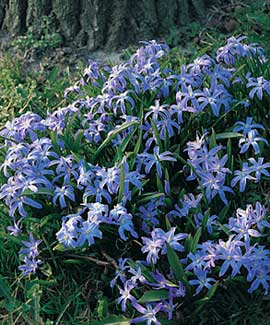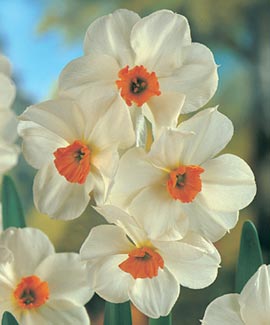|
September 2008
Monthly Musings on the Garden Scene
***********************************************************
If you prefer, you can view this month's issue online where you can also subscribe if this copy has been forwarded to you by a friend.
If you are reading the text version you will need to go online to see the videos.
***********************************************************
In this issue:
- Letter from the Editor
- Spring Flowers
- Plan Your Spring Bulb Garden Now
- Brighter Borders
- Zen Garden Design
- Special Offers
- Tailpiece
***********************************************************
Hi
Welcome to the September issue of Garden Ramblings. For a change there is only one guest author this month, but he has written quite a substantial article.
But we start with a reminder that if you want to fill your garden with spring flowers, now is the time to make your plans and buy the bulbs ready for planting in October.
This month's guest author is Steve C Boulden and the full title is "Zen Garden Design - Principles And History". In fact there is not much history, but the first paragraph explains the philosophy of the zen garden. He then proceeds to examine the different features giving a comprehensive review of the subject. It's quite a read, but well worth the effort.
In between there is a short filler from me on Brighter Borders and confusing plant names.
As usual there is a Special Offers section with all the bargains that I've managed to find this month.
The video this month is a gentle introduction to those spring flowers.
Enjoy the issue.
Hugh
***********************************************************
Spring Flowers
***********************************************************
Plan Your Spring Bulb Garden Now
For many people Spring is the best season of the gardening year. All those signs of new life as the green shoots appear after the cold and dark of winter are eagerly awaited by all keen gardeners. And what better way to start the new year than with a display of spring-flowering bulbs? The beauty of it is that you only need to spend a couple of hours during the fall to plant your bulbs and then let nature take its course.
With a little planning you will be able to enjoy a succession of flowers from March until May. In the list below you will find a selection of plants divided into four categories. Choose one or two from each group and you will be assured of a good succession of flowers. Although the onset of spring will vary depending on where you live, the bulbs will bloom in succession starting whenever winter ends.
Very Early Spring
Chionodoxa (Glory-of-the-snow)
Winter aconite
Scilla siberica (Star of Holland)
Snow crocus
Iris reticulata (reticulated iris)
Early Spring
Crocus
Early daffodil
Emperor tulip
Mid-Spring
Species tulip
Hyacinth
Daffodil
Muscari (grape hyacinth)
English bluebell
Fritillaria imperialis (crown imperial)
Late Spring
Allium
Dutch iris
Iris pumila (dwarf iris)
Late tulips
Leucojum aestivum (summer snowflake)
Here's a planting scheme suggested by Kathy LaLiberte of Gardener's Supply Company using bulbs from the Dutch Gardens catalog. It includes 195 bulbs for just under $120, and in most locations it will give you a nice variety of flowers for at least eight weeks.
Very Early Spring
Snow Crocus Mixture 
1 bag (50 bulbs) $13.95
Early Spring
Chionodoxa forbesii 
1 bag (50 bulbs) $11.95
Segovia Daffodil 
1 bag (10 bulbs) $8.95
Mid-Spring
Blue Grape Hyacinths 
1 bag (25 bulbs) $9.95
Pink Impression Tulip 
1 bag (10 bulbs) $11.95
Geranium Daffodill 
1 bag (20 bulbs) $17.95
Late Spring
Zurel Tulip 
1 bag (10 bulbs) $14.95
Maureen Tulip 
1 bag (10 bulbs) $11.95
Royal Acres Double Tulip 
1 bag (10 bulbs) $11.95
***********************************************************
Brighter Borders

Recently I was reading a gardening column in the London Sunday Telegraph when I found a tip for "Brighter Borders". Asters, Sedum and Liriope Muscari was their suggestion for late season color. As you can see my sedums are in full bloom, but my asters have yet to flower. When I saw "muscari" I immediately thought of the Grape Hyancinth which, of course, is a spring flowering bulb, so how could that provide late season color? A quick check in my plant encyclopedia soon put me right. Liriope Muscari does indeed flower from August to November. Interestingly my encyclopedia says that the flowers resemble a grape hyancinth.
Talking of plant names, the constant changes in the official botanical classification can cause confusion. It took me long enough to remember that bluebells are endymion and not scilla. Earlier this year I wasted a lot of time searching garden centers for Polygonum, a clump forming plant with pink flower spikes which I wanted to fill a spot beside my stream. I finally discovered that it is now known as Persicaria and was then able to find the plants without further difficulty. ************************************************************* Zen Garden Design - Principles And History
by Steve C Boulden
Zen gardens, originating with Buddhist monks centuries ago, have become all the rage recently. Combining a balance of natural and architectural elements and a blend of humble, simple design juxtaposed with natural wonders, these gardens offer tranquility and beauty galore. As for that balance, Zen gardeners adhere to the principle of (female) yin and the (male) yang. Every facet of a Zen garden is characterized by one or the other, i.e. water is yin; earth is yang. The epitome of a Zen garden is achieved when yin and yang balance for harmonious feng shui; this adheres to a second principle of working with nature's tendencies as much as your landscape allows.
Designed to produce a 3-D effect of height and depth, a Zen garden is planned with foreground and background to draw one's focus. More harmony is achieved by balancing different colors, sizes, and shapes of flora, so no one plant overwhelms. Trees and larger shrubbery placed at the rear of your garden offer privacy and a natural backdrop.
More feng shui tips for your Zen garden?
Planting for your climate: Mosses, ground covers, ornamental grasses, hardy flowering blooms, shrubs, and focal point trees, in varied heights, colors, and textures, add lush vibrancy to your garden. Drought-resistant plants thrive in a Zen garden's sandy areas and are perfect for low-rainfall zones. Mosses and low-maintenance ground covers serve to soften straight lines, such as pre-existing walkways, and promote the flow of chi. Choose plants that will flourish in your region.
Nature's Rocks: Rocks give dimension to a Zen garden. They reflect permanence and respect for the passing of time, while adding energy and emotion to your landscape. Select unique rocks and stones, organizing them according to their special characteristics and sizes; place them where best suited for your garden's flow. Choose smooth, well-worn stones for added appeal.
Water Features: All elements have a purpose in a Zen garden. Water features such as pools, ponds and fountains offer yin energy and encourage beneficial chi. Garden lighting to highlight special areas balances that with yang (male) energy. You get the idea. Water elements can include natural facets already in your landscape, i.e. a pre-existing stream or pond, or may be added either naturally or man-made. Sand and pebble formations can also be used to represent water: swirl sand with a rake or fingertips to create a rippling water effect - the swirls also promote the flow of chi in your garden. While sand areas are lovely, I prefer using them in tandem with actual water features for more dramatic appeal.
Paths and Walkways: Paths should never be straight, as chi energy is supposed to flow gently. A Zen garden craves meanderings and curves to soften straight lines and edging, because a curved path encourages chi to move more slowly and freely. If you already have straight paths, plant mosses to soften them; allow plants to grow over edges to help chi to circulate freely.
Bridges: Most of us have seen the stock photo print or done a jigsaw puzzle of the Zen garden with the small red bridge spanning across a pond of water lilies or was it lotus flowers? Regardless, bridges add beauty and evoke emotion to any type of garden and are one of the architectural elements most often added to a Zen garden. Employ them to span a water feature, to connect different garden areas, and to offer access and views of your garden that would be unattainable otherwise.
Focal Points and Decorative Ornaments: These are other architectural features to enhance the atmosphere in your garden and create a sense of space. A hanging lantern, Buddha statuary, or mahogany woodwork add to the feel of a Zen garden. A well-placed, unique boulder partially embedded in the earth and a few solar yard lights to complement your special features will add beauty in a holistic way.
Gates and Arbors: One of the finest features of a Zen garden? You can create one anywhere even in the smallest of space. Through well-planned placement of features, the illusion of more area and depth is possible. A gate situated at your garden entrance will enhance the illusion of extra space. Arbors draw the eye near or far and are wonderful ways to give the essence of privacy while adding to your garden's beauty. Climbing vines work well here to promote a sense of tranquility.
Whether a special, eye-catching niche in your yard or an all-encompassing theme, a Zen garden provides a beautiful spot for relaxing and pondering. Above all, your Zen garden should offer outdoor living space for sharing with family and friends.
About the Author
For more on Zen gardens, do it yourself landscaping ideas, home repairs, home improvement, interior decorating, and interior design, visit the site. Get more information regarding zen garden. *************************************************************
Special Offers
With one exception it's still too early in the year to find sales of gardening products or special bargains so there is little to report this month.
The Summer Sale at Gardener's Supply Company is still running - up to October 11 they say. Up to 50% savings are to be found on numerous items. Click the banner and look for Summer Sale.
 
Dutch Gardens have finished their Spring Sale but you can still save $25 when you spend $50 as shown on the banner.
 
Nothing special at Gurney's Seed & Nursery Co this month, but as you see from the banner you can still save $20 when you spend $40 or more.

This month Nature Hills Nursery are offering savings of at least 50% on 170 clearance items.

********************************************************
Tailpiece
St. Louis Zen Garden
************************************************************
Please feel free to pass on this newsletter to your gardening friends. Do let me have your feedback and suggestions to: [email protected]
That's all until next month but in the meantime you can always look at my Blog Garden Supplies News | 







